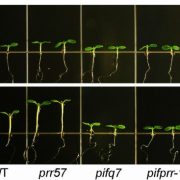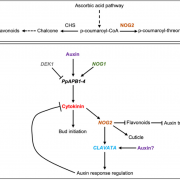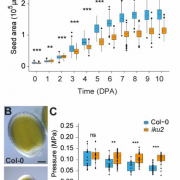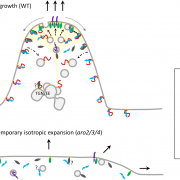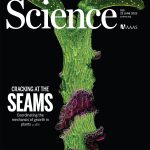Light and sucrose signaling converge at TOR kinase to control plant development
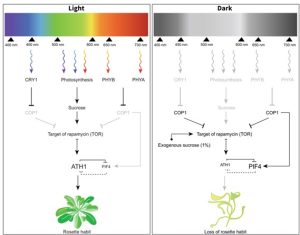 Different photoreceptors (mainly phytochromes and cryptochromes) perceive light, which acts as a signal for controlling plant growth and development. Similarly, light is absorbed by chlorophylls (and carotenoids) for generating energy via photosynthesis. In search of a link between these two light-mediated processes, Hajibehzad et al. explored a gene, ARABIDOPSIS THALIANA HOMEOBOX GENE1 (ATH1) induced by both light and sugars, and controlling the rosette habit in Arabidopsis. Similar morphology (lack of rosette habit) in ath1 and photoreceptor (phy, cry) mutants revealed a double negative feedback regulation between ATH1 and PHYTOCHROME INTERACTING FACTORS (PIFs) in the shoot apical meristem (SAM) which can possibly act as a switch during the vegetative to floral transition phase. High sugar availability to the SAM can overcome the light requirement for ATH1 expression. Increased expression of ATH1 and a related increase in the inhibition of vegetative internode elongation occurred in response to rising sucrose concentrations. Light and sucrose can act as signals as well as energy sources. Through strategically defined experiments, the group identified that the rosette habit was controlled by the signaling property of light and the energy property of both light and sucrose. TARGET OF RAPAMYCIN (TOR) kinase, a central component in energy sensing, must be activated for ATH1 to be induced at the SAM by both metabolic and light signals. Thus, light and sucrose signaling pathways converge at TOR kinase to control ATH1 expression and subsequent rosette growth habit in Arabidopsis thaliana. (Summary by Rajarshi Sanyal, @rajarshi_sanyal) New Phytologist 10.1111/nph.19014)
Different photoreceptors (mainly phytochromes and cryptochromes) perceive light, which acts as a signal for controlling plant growth and development. Similarly, light is absorbed by chlorophylls (and carotenoids) for generating energy via photosynthesis. In search of a link between these two light-mediated processes, Hajibehzad et al. explored a gene, ARABIDOPSIS THALIANA HOMEOBOX GENE1 (ATH1) induced by both light and sugars, and controlling the rosette habit in Arabidopsis. Similar morphology (lack of rosette habit) in ath1 and photoreceptor (phy, cry) mutants revealed a double negative feedback regulation between ATH1 and PHYTOCHROME INTERACTING FACTORS (PIFs) in the shoot apical meristem (SAM) which can possibly act as a switch during the vegetative to floral transition phase. High sugar availability to the SAM can overcome the light requirement for ATH1 expression. Increased expression of ATH1 and a related increase in the inhibition of vegetative internode elongation occurred in response to rising sucrose concentrations. Light and sucrose can act as signals as well as energy sources. Through strategically defined experiments, the group identified that the rosette habit was controlled by the signaling property of light and the energy property of both light and sucrose. TARGET OF RAPAMYCIN (TOR) kinase, a central component in energy sensing, must be activated for ATH1 to be induced at the SAM by both metabolic and light signals. Thus, light and sucrose signaling pathways converge at TOR kinase to control ATH1 expression and subsequent rosette growth habit in Arabidopsis thaliana. (Summary by Rajarshi Sanyal, @rajarshi_sanyal) New Phytologist 10.1111/nph.19014)


